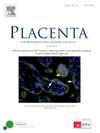SPARC expression in the mouse decidua, placenta, and fetus: correlations with SPP1 expression
IF 3
2区 医学
Q2 DEVELOPMENTAL BIOLOGY
引用次数: 0
Abstract
Introduction
Secreted protein acidic and rich in cysteine (SPARC) and secreted phosphoprotein 1 (SPP1) are matricellular proteins implicated in many physiological processes including cell migration, tissue remodeling, and angiogenesis. The role of SPP1 in the pregnancies of many species has been studied extensively, however the contributions of SPARC to pregnancy are not well understood.
Methods
Here, we examine the localization of Sparc mRNA and protein in mouse fetuses, endometrial decidua, and placentae during various days of pregnancy in the delayed implantation model to identify potential interactions between SPARC and SPP1 in mouse pregnancy.
Results
In situ hybridization and immunofluorescence microscopy localized Sparc mRNA and protein to the endometrial stroma at implantation sites on gestational day (GD)5–6, and to the parietal yolk sac, Reichert's membrane, and select trophoblast lineages on GD9-16. Spp1 mRNA is strongly expressed in the endometrial luminal epithelium at inter-implantation sites and SPP1 is detected in uterine natural killer cells (uNKs) and glycogen trophoblast cells of the placenta. SPARC and SPP1 both localized to many regions of the GD16 fetus, including separate chondroblastic lineages within the developing cartilage.
Discussion
The placental expression pattern of these two matricellular proteins suggests possible spatio-temporal and mechanistic relationships between SPARC and SPP1 during pregnancy. While future studies are needed to elucidate the functional roles of SPARC, results from this study demonstrate that SPARC is a prominent component of the matricellular milieu throughout gestation.
小鼠蜕膜、胎盘和胎儿中SPARC的表达:与SPP1表达的相关性
酸性和富含半胱氨酸的分泌蛋白(SPARC)和分泌磷酸化蛋白1 (SPP1)是参与许多生理过程的基质细胞蛋白,包括细胞迁移、组织重塑和血管生成。SPP1在许多物种妊娠中的作用已被广泛研究,但SPARC在妊娠中的作用尚不清楚。方法在延迟着床模型中,我们检测了不同妊娠时期小鼠胎儿、子宫内膜蜕膜和胎盘中Sparc mRNA和蛋白的定位,以确定Sparc和SPP1在小鼠妊娠中的潜在相互作用。结果原位杂交和免疫荧光显微镜将Sparc mRNA和蛋白定位于妊娠5 ~ 6天着床部位的子宫内膜间质、卵黄囊壁、赖氏膜,并选择了gd9 ~ 16的滋养细胞谱系。Spp1 mRNA在着床间部位的子宫内膜腔上皮中强烈表达,在胎盘的子宫自然杀伤细胞(uNKs)和糖原滋养细胞中检测到Spp1。SPARC和SPP1都定位于GD16胎儿的许多区域,包括发育中的软骨中独立的成软骨谱系。这两种基质细胞蛋白的胎盘表达模式提示妊娠期间SPARC和SPP1之间可能存在时空和机制关系。虽然需要进一步的研究来阐明SPARC的功能作用,但本研究的结果表明SPARC是整个妊娠期基质细胞环境的重要组成部分。
本文章由计算机程序翻译,如有差异,请以英文原文为准。
求助全文
约1分钟内获得全文
求助全文
来源期刊

Placenta
医学-发育生物学
CiteScore
6.30
自引率
10.50%
发文量
391
审稿时长
78 days
期刊介绍:
Placenta publishes high-quality original articles and invited topical reviews on all aspects of human and animal placentation, and the interactions between the mother, the placenta and fetal development. Topics covered include evolution, development, genetics and epigenetics, stem cells, metabolism, transport, immunology, pathology, pharmacology, cell and molecular biology, and developmental programming. The Editors welcome studies on implantation and the endometrium, comparative placentation, the uterine and umbilical circulations, the relationship between fetal and placental development, clinical aspects of altered placental development or function, the placental membranes, the influence of paternal factors on placental development or function, and the assessment of biomarkers of placental disorders.
 求助内容:
求助内容: 应助结果提醒方式:
应助结果提醒方式:


